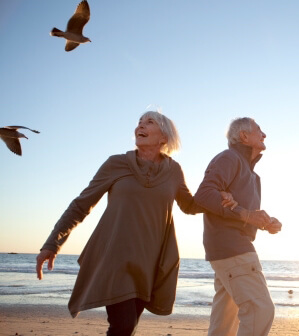Balance is a skill that we all too often take for granted, until it starts becoming a problem and making the completion of our every day tasks such as walking, getting dressed, showering or navigating stairs that little bit more difficult. As we age it is common for people to experience a decline in their ability to keep their balance, as well as being able to save themselves from suffering a fall after tripping.
Repeated trips and/or falls can have a huge impact on a persons mental and physical wellbeing. It can result in a loss of independence and mobility, create a fear of falling, as well as reduce confidence in walking and other activities of daily living. Falls can have some extremely serious consequences including permanent disability and even death (3). Falls-related injury is one of the leading causes of morbidity and mortality in older Australians, accounting for more than 80% of injury-related hospital admissions in people aged 65 years and over (3).
In fact, one in three older Australians (over the age of 65 and not living in a nursing home) are likely to suffer a fall at least once every year, and it is believed 10 to 15 percent of these falls result in serious injury (3). By 2051, the annual health bill for fall-related injuries in Australia is expected to reach $1.4 billion (2).
What can cause loss of balance and falls?
Falls can be caused by a large number of different factors including both patient specific and environmental risk factors (1). Key factors include age, poor eye sight, reduced lower limb strength and joint flexibility, cognitive decline and slower reaction times. The impact from other medical conditions (e.g. stroke, Parkinson’s Disease, peripheral neuropathy) or certain medications (e.g. Psychoactive drugs) can also contribute to a persons increased risk of falling.
Environmental risk factors may include uneven or slippery surfaces, tripping hazards (e.g. floor mats and garden hoses), incorrect footwear and poor lighting. It is important to note that falls commonly occur as result of a combination of risk factors, rather than just one in isolation.
How can exercise help improve our balance and reduce our risk of falls?
Keeping balance involves the interaction of various sensory and motor systems including vision, the vestibular system in the inner ear and proprioception (i.e. the ability to sense the position, location and orientation of each body part in relation to other parts) (4). Receptors in our joints and muscles also help to relay information back to the brain about movement and positioning of the body.
As we age the integration of information from these sensory and motor systems can start to slow, making coordination of the limbs and adjusting to changes in the bodies positioning during movement more challenging. This decline is often compounded by physical inactivity which leads to a reduction in muscle mass, joint range of motion and fitness.
Physical activity has been shown to the be the most promising falls prevention strategy for older people living in the community, with research showing that specific exercises such as Tai Chi, balance, gait training and strength building group classes, or individualised in-home programs can reduce falls risk by 12% and the number of falls by 19% (3).
Regular exercise can help improve balance, muscular strength (providing greater support to the joints), build confidence and mood, increase walking pace and improve flexibility (for greater joint mobility) (2).
Balance training should be performed on a regular basis, be challenging, progressive in nature and be of sufficient duration (at least 2 hours per week)(1). Continuing this type of training long term will give the best chance of reduced falls risk. (2). In addition to exercises for dynamic balance, exercises to help build strength and endurance (especially of the lower limbs), as well as posture and gait training are also recommended.
Exercises
Below are some balance and lower limb strengthening exercises you may like to try at home to help improve your balance and reduce your risk of falls. Always make sure that you are performing exercises near adequate support, as needed. The goal is to use support as required but as little as possible.
Heel/ Toe walking
- Position the heel of one foot just in front of the toes of the other foot. Your heel and toes should touch or almost touch.
- Choose a spot ahead of you and focus on it to keep you steady as you walk.
- Take a step. Put your heel just in front of the toe of your other foot.
- Repeat for 20 steps.
*An ideal place to perform this exercise is down a hallway or along side a table/ bench.
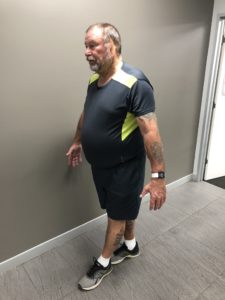
Single leg balance
- Stand behind a sturdy chair.
- Using the chair for support, lift one foot up off the ground.
- Try and hold position for up to 10 seconds.
- Repeat 10 times on both legs
- Rest, before performing a further 10 times on each leg.
*When you start to find this exercise is getting easier try reducing the amount of support you use (i.e. reduce to only one hand, then to only a couple of fingers to no hands at all).
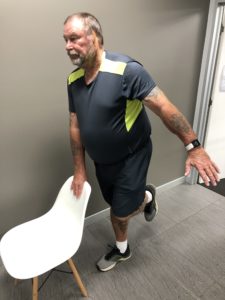
Calf Raisers
- Stand up straight behind a chair.
- Using support as necessary, rise up onto toes (i.e. balls of feet).
- Pause for a few seconds before lowering heels back down to the ground.
- Repeat 2 lots of 10-12 repetitions.
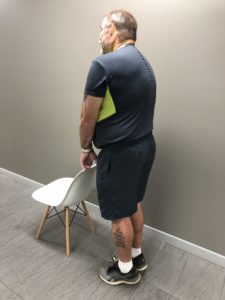
Sit to stands
- Sit in a high sturdy chair and position the buttocks towards the edge of the chair.
- Lean forward slightly from the waist while keeping the back straight. Push up through the legs into a standing position.
- Pause, before poking the buttocks out and sitting back down onto the chair. Return dumbbells back down to the starting position.
- Repeat 2 lots of 10-12 repetitions
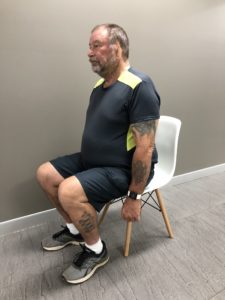

For further information on how to reduce your risk of falls or to have an individualised program created for you to improve your balance and mobility please contact Northside Allied Health on 0412 740 322 to organise an appointment with one of our Exercise Physiologists.
References:
1. Australian Family Physician- www.racgp.org.au/afp/2012/december/falls-prevention
2. Exercise is medicine- www.exerciseismedicine.com.au
3. Queensland Health- health.qld.gov.au
4. Australian Institute of Health and Welfare- https://www.aihw.gov.au

